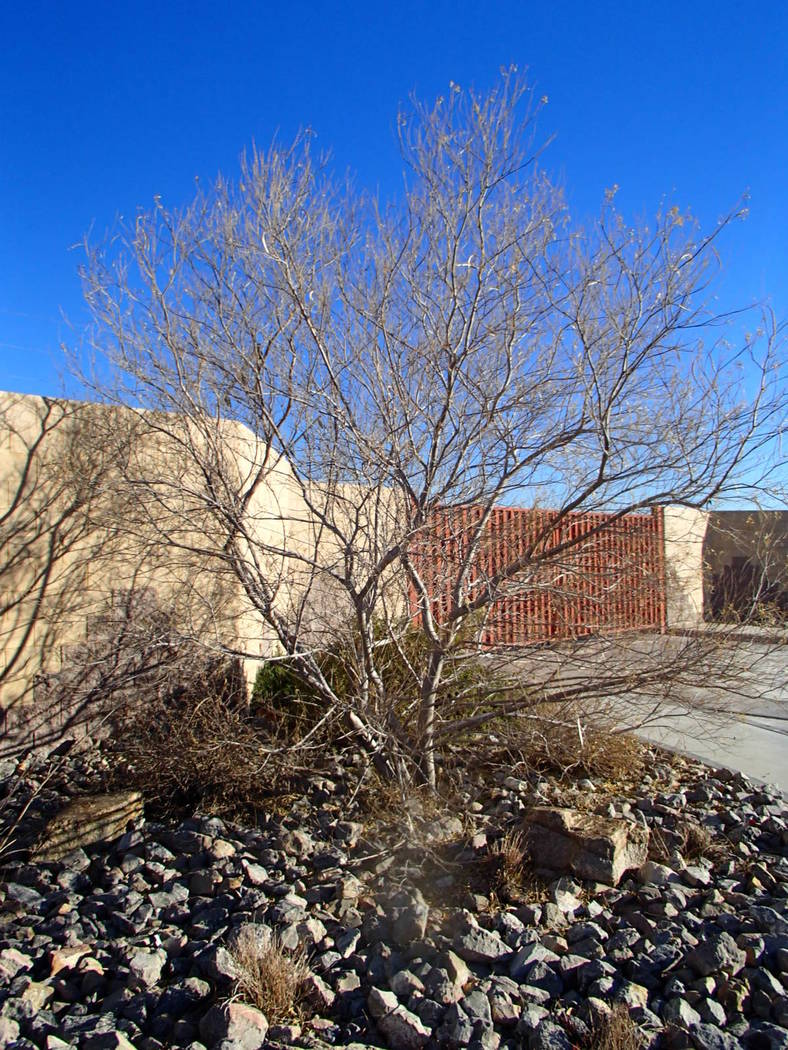Olive tree will outgrow container so plant in ground
Q: I received a 2-year-old olive tree grown in a 15-inch container. The brochure attached advised planting in the ground 15 feet away from building structures. My tree is 5 feet high with a ½-inch stem. Not having a suitable area to plant, can this tree survive growing in a large container instead of in the ground?
A: No. A tree this size should be planted in the ground. The ornamental Swan Hill or Wilsonii olive variety has a mature size around 25 to 30 feet tall with a canopy spread of an equal size. Unless the container is at least 12 feet in diameter and 4 feet deep, plant it in the ground.
A recommendation of 15 feet away from buildings or structures is really playing it safe. You could plant the tree as close as 8 feet and not have a problem if you keep irrigation water away from a wall, foundation or structure. This is one reason growing plants in the desert with irrigation can be superior to rainfed regions.
If this area is only 3 or 4 feet wide, then it’s too small of any medium-size tree. A small patio tree (10 feet tall) might work in a spot this small, but not one 25 feet tall. The tree can be pruned so that it doesn’t rub against the structure.
Applying water at least 3 feet away from a structure causes tree roots to grow where water is applied. Applying water a significant distance from structures keeps tree roots from growing under them and ultimately causing damage as the roots get larger.
Keeping the foundation or soil around the structure dry reduces damage from the salts in the soil and water and damaging cement. Tap water in the Las Vegas area and many of our soils contain a significant amount of salt that is corrosive to concrete structures.
Q: How do I get rid of all the brown in my desert willow so it doesn’t look so messy?
A: Desert willow can look shaggy during the winter because of the brown seedpods that hang from the tree. That is a winter characteristic of desert willow. Not much can be done about that. This is not a tree for tidy landscapes but more for landscapes that are “wild and woolly.”
Desert willow seedpods provide a good supply of birdseed for various desert birds during the fall and winter months. Unfortunately, the only method of getting rid of the pods is to cut them off by hand every year.
Q: My kids gave me a pomegranate tree one year ago this February. We dug a hole and tested its drainage, which was terrible. So we dug the hole deeper and drilled a chimney in the middle of the hole for better drainage. The water didn’t drain better, so we put a layer of gravel in the bottom of the hole and planted the tree on top of that. The tree gave us 18 pomegranates this year, so it seemed to work.
A: The gravel does nothing for drainage. Absolutely nothing. I think the soil drained well enough for pomegranate without the gravel, and that’s why you had success. When testing a planting hole dug for trees for drainage, it would be ideal if the water drained from the hole at about an inch per hour.
This seldom happens. A more realistic scenario in some of our desert soils would have the water drain from the hole overnight. This apparently slow drainage is still OK if you apply water one or two days later and let the soil around the roots dry out before the next irrigation. The roots will find the best air, soil and water mix to grow in.
If you fear that your soil does not drain water fast enough, then plant the tree on a mound instead of putting gravel at the bottom of the hole. Make the mound wide enough so that it occupies at least half of the mature trees canopy and is at least 12 inches deep after the soil has settled.
In the case of pomegranate with a mature spread of 20 feet, the mound should be at least 10 feet wide and 12 inches deep after settling. Covering this elevated mound of soil with 4 inches of wood chips helps with root growth and faster tree establishment.
Q: I’m starting some new plants for my backyard vineyard, and I want to use clippings from existing plants. I’ve read that younger players are not good to use for clippings. What do you feel is the minimum age for successful clippings from another plant?
A: Instead of age, I use the size of the cutting. Pencil-sized (diameter) cuttings are the best choice. Cuttings smaller than this won’t form roots as well. Cuttings larger than this might be too old and mature.
Cut below the bottom bud ¼ inch (perpendicular to the stem) and ½ inch above the top bud (angled cut). These different angled cuts (top and bottom) help you remain less confused about which end to stick into the soil. Four total buds are enough (8 to 10 inches long with two buds stuck beneath the soil). The cuttings can have more buds than this but not fewer than four.
Sanitation is very important. Sanitize the pruning shears used for cutting. Stick these cuttings in a sanitized 5-gallon nursery container and use fresh potting soil or similar soil mix that drains water easily. For good rooting, the container with cuttings should be kept warm and the soil moist but not wet. The main reason for failure is the lack of warmth and the soil kept wet or it dries out.
Rooting hormone (Hormex) speeds up the growth of roots from the buds beneath the soil, makes more roots and improves the chances of success. The most readily available type of rooting hormone is a dry powder. A small amount of rooting powder is removed from the container, and the bottom cut end is rolled in into the powder and then inserted in the soil. A clean pencil is used to make the hole in the soil so the powder isn’t rubbed off the cutting when it is stuck in the soil.
Ten cuttings per 5-gallon container gives them enough room for root development. After sticking the cutting in potting soil, put it near the south side of a wall for warmth and water daily if using potting soil. It needs warmth to grow roots, and the soil must not dry out.
Q: Are all dry fertilizers for roses to be applied to wet soil, raked in, then watered again?
A: Dry (granular) fertilizers need to be wet to move plant nutrients inside the plant. Some granular fertilizers dissolve in water faster than others. Just keep all fertilizers 18 inches from the main stem of established plants to prevent plant damage. If you apply in the right spots, irrigation water will dissolve it and move it toward plant roots. Granular fertilizers dissolve after several water applications.
Roses are fed three to four times a year, two months apart. These applications are usually during the spring and early summer months and then again in the fall. The total amount of fertilizer is subdivided into the number of applications you make. So, if you are making four applications in a year, the total amount is separated into four equal applications.
A full application of fertilizer is only applied once. Light frequent applications are better for plants than one applied all at once.
Q: I am new to the desert and gardening and want to grow my own berries or fruits. Some guidance is greatly appreciated. I would use beds or pots, since I have almost no bare soil space available. I want to grow something small, easy to manage and rewarding when harvested.
A: Growing in containers means your focus should be on small or genetic dwarf fruit trees for the least care. None will be care-free. They all require some form of management. Even cacti grown for fresh vegetable (nopalitos) or fruit (fruitas or tuna) require management.
Genetic dwarf apricot such as Garden Annie is probably your best choice regarding reliability of production and ease of care. Also, consider genetic dwarf peach such as Bonanza. The most cold-hardy small citrus suitable for containers is probably kumquat. Limes are small trees but can be unreliable in their production of fruit in our cold desert.
Bob Morris is a horticulture expert and professor emeritus of the University of Nevada, Las Vegas. Visit his blog at xtremehorticulture.blogspot.com. Send questions to Extremehort@aol.com.





























